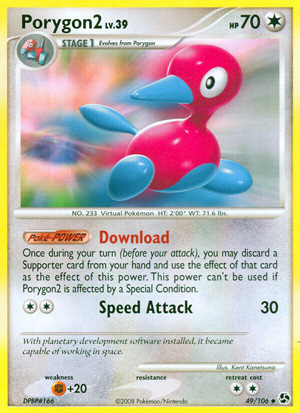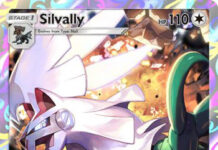
Porygon2 – Great Encounters
Date Reviewed: August 5, 2021
Ratings Summary:
Standard: N/A
Expanded: N/A
Ratings are based on a 1 to 5 scale. 1 is horrible. 3 is average. 5 is great.
Reviews Below:

Otaku
Porygon2 (DP – Great Encounters 49/106) officially released on February 13, 2008. It is a Colorless Pokémon from a time when Colorless Weakness and Resistance were a thing, but this wasn’t the selling point of the card. It was a Stage 1 during a period when Evolution acceleration was plentiful and potent, so that wasn’t a problem, either. 70 HP wasn’t awful for a Stage 1 back then, though I wouldn’t call it good, either. [F] Weakness was still dangerous, no Resistance was still typical, and a Retreat Cost of [CC] was neither a benefit nor a drawback. Just to get it out of the way, Porygon2 knows “Speed Attack”. Priced at [CC], it does 30 damage. Again, not as bad as it would be in the present, but also not “good” when Porygon2 was new.
Porygon2 has the Poké-Power “Download”. The short version is that “Poké-Powers” are pretty much Abilities by another name, and counting as a distinct mechanic. Download may be used once per instance, during your turn and before you attack or do anything else that would end your turn. It can’t be used when Porygon2 is affected by a Special Condition. Oh, and it lets you discard a Supporter then use the effect(s) of that Supporter as the effect(s) of Download. In other words, each Porygon2 is basically a bonus Supporter usage for the turn. Now, it still counts as a Poké-Power, so anti-Poké-Power effects block it while anti-Supporter effects do nothing, but you have to discard the Supporter Download emulates from your hand, so close enough.
Download sounds amazing, and I’m sure it would be in the modern metagame. Something for every deck? No. We’re at a point when Bench damage is pretty big, and soon we’ll lose Mew (SM – Unbroken Bonds 76/214; SM – Black Star Promos SM215) and its “Bench Barrier” Ability. Still, a deck able to commit to Porygon2 could run heavy on Supporters, and enjoy stacking them together. An opponent who could both draw big and use Boss’s Orders, or hit both player’s with Marnie but then play that hand out before using Download to discard and copy the effects of Professor’s Research. In fact, that is with just one copy. A deck running multiple might pull off as many as five Supporters in a turn!
How was it used historically? I… don’t know. Not for the Standard Formats of the time, anyway. Porygon2 released around the time I had to focus on work and not the Pokémon TCG. In short, I couldn’t keep up with the metagame, so all I can trust are accounts by others of this era. I’m not seeing Porygon2 mentioned for Standard, what was then called “Modified”. So why are we looking at this card? The Unlimited Format. A little confusing is that we’re considering both an older Unlimited Format, as well as the present. When the deck first came about was when the Black & White-era First Turn Rules went into effect. This is before Pokémon-EX joined the cardpool.
A “donk” in Pokémon is when you win on your first turn because you were able to Bench Out your opponent, usually by OHKOing their only Pokémon in play. Donk decks are built entirely around the mechanic. First Turn Win decks are a broader category, as they include decks that win or functionally win Turn 1. In this case, “functionally” means we also include things such as lock decks that your opponent may as well concede to once the lock has been established. Porygon2 features in two such decks. Probably more, actually, as the deck I am thinking of is itself a synthesis of two other decks: “Porydonk” or “Sabledonk”. It is possible my memory is playing tricks on me, or the blend was just a “local” thing, but I think my Search-Fu just failed me.
Especially in the Unlimited Format around the time this deck was born, it’s backbone would consist of the powerful Trainers consigned to the Unlimited Format. Cards such as Computer Search, Erika, Item Finder, Professor Oak, Gust of Wind, etc. Note that some of these were later nerfed through reprints. This is Computer Search back before it was an Ace Spec, and Erika before she was reprinted as a Supporter, and thus was actually treated as an Item card. Besides these, let us address some of the deck specifics:
- Sableye (DP – Stormfront 48/100) was a good opener in general before more recent rulings nerfed it. Its “Overeager” Poké-Body (also like an Ability) meant that, if you opened with it as your Active, you automatically went first. Barring an opponent who also had it: when that happened, you worked out who went first as normal. I’m pretty sure this trick no longer works, because we decide who goes first before revealing our in-play Pokémon. Its “Impersonate” attack doesn’t feature into our strategy, but “Overconfident” just costs [D] and does 40 damage if your attacking something with less HP than Sableye.
- Crobat {G} is a Basic Pokémon with a coming-into-play Poké-Power, “Flash Bite”. Flash Bite lets you place a damage counter on one of your opponent’s Pokémon. Team Galactic’s Invention G-105 Poké Turn is an Item that lets you bounce a Pokémon SP, and Crobat [G] is a Pokémon SP. The Unlimited Format also had Scoop Up, giving you up to 8 Items to bounce Crobat {G}
- Broken Time-Space let you evolve your Pokémon as many times as you wanted (and were able) in a turn.
- Seeker is a Supporter that forces each player to bounce a Pokémon from their Bench back into their hand.
When you put it all together, you get an almost guaranteed Donk. You’ve got the Unlimited Format’s Trainer-engine to reliably setup, which includes using Gust of Wind to force your opponent’s smallest Pokémon into their Active position. Broken Time-Space not only meant a Turn 1 Porygon2, but using Seeker via Download meant you could opt to bounce that Porygon2, and immediately Bench Porygon then evolve to Porygon2. Which would reset Download, so you could do it all again so long as you had another Seeker in your hand. Assuming you needed to bounce more of your opponent’s Bench. If they were already down to their Active, you would spam Flash Bite instead, until your opponent’s Active was OHKO’d or it was within OHKO range of Sableye.
This doesn’t work anymore. The XY-era (and later) Turn 1 rules prevent you from attacking Turn 1. Maybe this cleared up the Unlimited Format, but I doubt it. All the other pieces of the combo still function, so I think reliability just took a hit, since you can still shoot for a donk through non-attack effects. The real concern I have are modern HP scores; some Rule Box Pokémon are massive. It is quite possible by now that, so long as you stick to things like TAG TEAM Pokémon, your opponent just won’t be able to place enough damage counters to score the OHKO. Honestly, being given a choice between donk decks or those built around only the highest HP scores, I still don’t have much interest in the Unlimited Format.
Why review Porygon2 now? I finally realized we’d never officially reviewed it before, and thanks to some other reviews, Porygon cards were on my mind. No scores, as this card is no longer Standard or Expanded-legal.
We would love more volunteers to help us with our Card of the Day reviews. If you want to share your ideas on cards with other fans, feel free to drop us an email. We’d be happy to link back to your blog / YouTube Channel / etc. 😉
Click here to read our Pokémon Card of the Day Archive. We have reviewed more than 3500 Pokemon cards over the last 17+ years!



